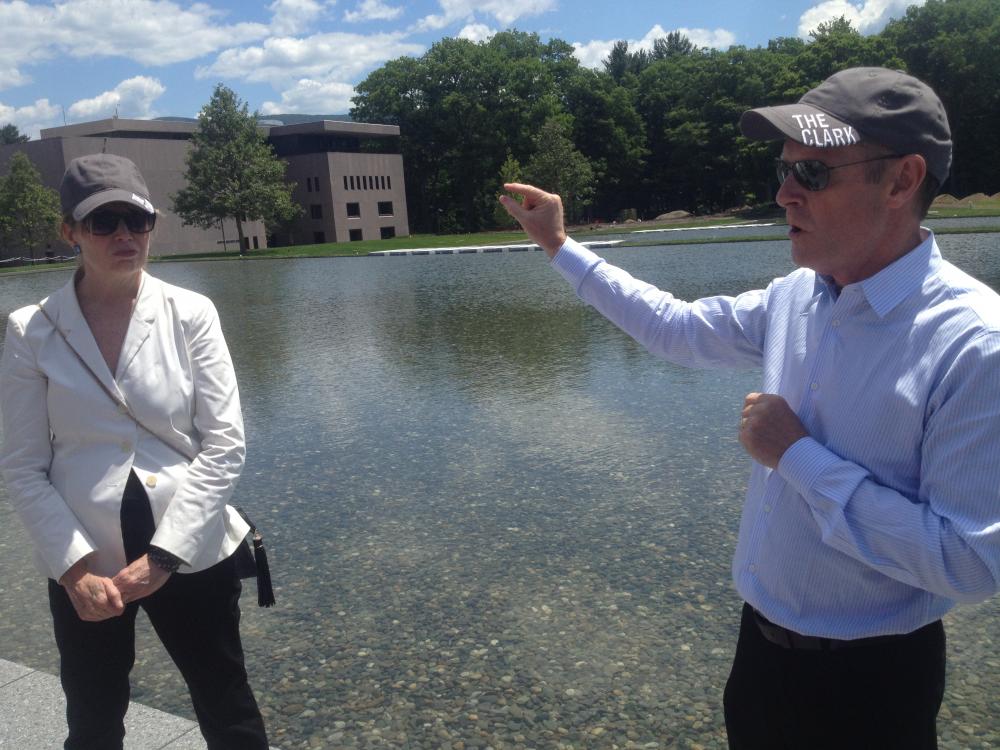Nestled in the northwest corner of Berkshire County, the Sterling and Francine Clark Institute—known most commonly just as The Clark—houses a noted collection of 18th and 19th century artwork. It’s been closed since March, in the final stages of a construction project over a decade in the making. The process spurred this Williamstown museum to seek donations far and wide, and—for a few years—even remove its most-prized paintings from view. Now back at full strength, the Clark has a new look and hopes to take advantage of its out-of-the-way location.
Exactly one week before the museum was due to re-open, workers in hardhats drove forklifts around, putting the finishing touches on a $145 million renovation and construction project. The main attraction is a sleek, concrete building designed to look unobtrusive, tucking much of its more than 42,000 square feet below ground level, where natural light filters down to create a surprisingly airy effect.
Upstairs, a short passageway leads visitors to the defining view of the new setup: three terraced pools, rippling quietly. On one side sit the Clark’s two older buildings, housing its permanent collection and art library. On the other side, hiking trails disappear into the woods, and a sloping hill is home to the cud-chewing neighbors next door.
“What we’re looking at here to the south is a pastoral agricultural landscape, as it were. And the field is mowed occasionally, but it’s mainly kept that way by the cows,” says landscape architect Gary Hilderbrand.
Though most of the world’s major fine-art museums are found in urban areas, the re-design here puts the focus squarely on the rural surroundings.
“It’s pretty rare to see cows from a museum. And, you know, we kind of like that and we capitalize on that,” Hilderbrand says.
A long, glass-enclosed walkway offers expansive views and a new entrance to the main building. That’s where a collection of Winslow Homer seascapes greets visitors in space previously filled by offices.
Museum leaders call this the most significant building project since the place first opened in 1955 as a showcase for the Clarks’ personal collection. Planning began in two thousand and one, and the job required the organization’s first-ever capital campaign, which raised over $145 million—a hefty sum in the world of Berkshire County cultural organizations.
Museum director Michael Conforti notes that the project weathered the post-9/11 economic downturn as well as the financial crisis of 2008.
“We have survived significant financial crisis…and there were absolutely times where we and every organization, every non-profit organization in the country wondered what their future was going to be look like. We may have wondered more significantly only because we had more at stake. We were building this building,” he says.
Nancy Harvin, the Clark’s chief fundraiser, says about half of the private donors to the campaign live in the Berkshires at least part-time, but most of the total funds raised—about 85 percent—came from outside the region.
“We are of the Berkshires but we are not fully dependent on the Berkshires for the funding,” Harvin says. “And the Clark is not unique in this regard at all.”
Part of the long-term plan included sending a collection of the Clark’s prized, French Impressionist paintings on an international tour while galleries were renovated. For three years, works by Monet, Renoir and Manet, typically the highlight of a visit here, were away on the road.
Now they’re home again, and with extra gallery space the museum can display large-scale modern work that couldn’t be accommodated by the original, 59-year-old loading dock.
Senior curator Richard Rand says an exhibition opening in August will include works by “Jackson Pollock, Mark Rothko, Frank Stella, Ellswowrth Kelly. And that’s the kind of exhibition that we never could have shown in our former special galleries. Now we can pretty much do whatever sort of exhibition we might want.”
The new-look Clark opens to the public on July 4th. The cows are already in place.
